On a temperate August afternoon, a girthy black carpenter bee with a cape of yellow fuzz circled around the stump that started it all.
“I swear to you, they recognize us,” 47-year-old Francesco Cura said of the bee as it dove into the base of a palm tree once filled with trash and reeking of urine on a strip of land between the sidewalk and the street in the heart of East Hollywood.
Four years ago, in the early days of the COVID-19 pandemic, Cura became so infuriated by the state of the stump that he decided to clean it up — along with the surrounding parkway. Longtime friend and fellow photographer Jim Stewart, 53, joined the effort, and together they jammed the mess into derelict shopping carts and hauled it all to a trash bin.
Now the former dumping ground on Normandie Avenue and Harold Way comes up on Google Maps as “The Magical Park” — a tag given to it not by Cura or Stewart but an apparently awed visitor.
There is something subtly enchanting about the area crammed with a haphazard assortment of foliage, much of which was donated, rescued from the trash or sprung up on its own.
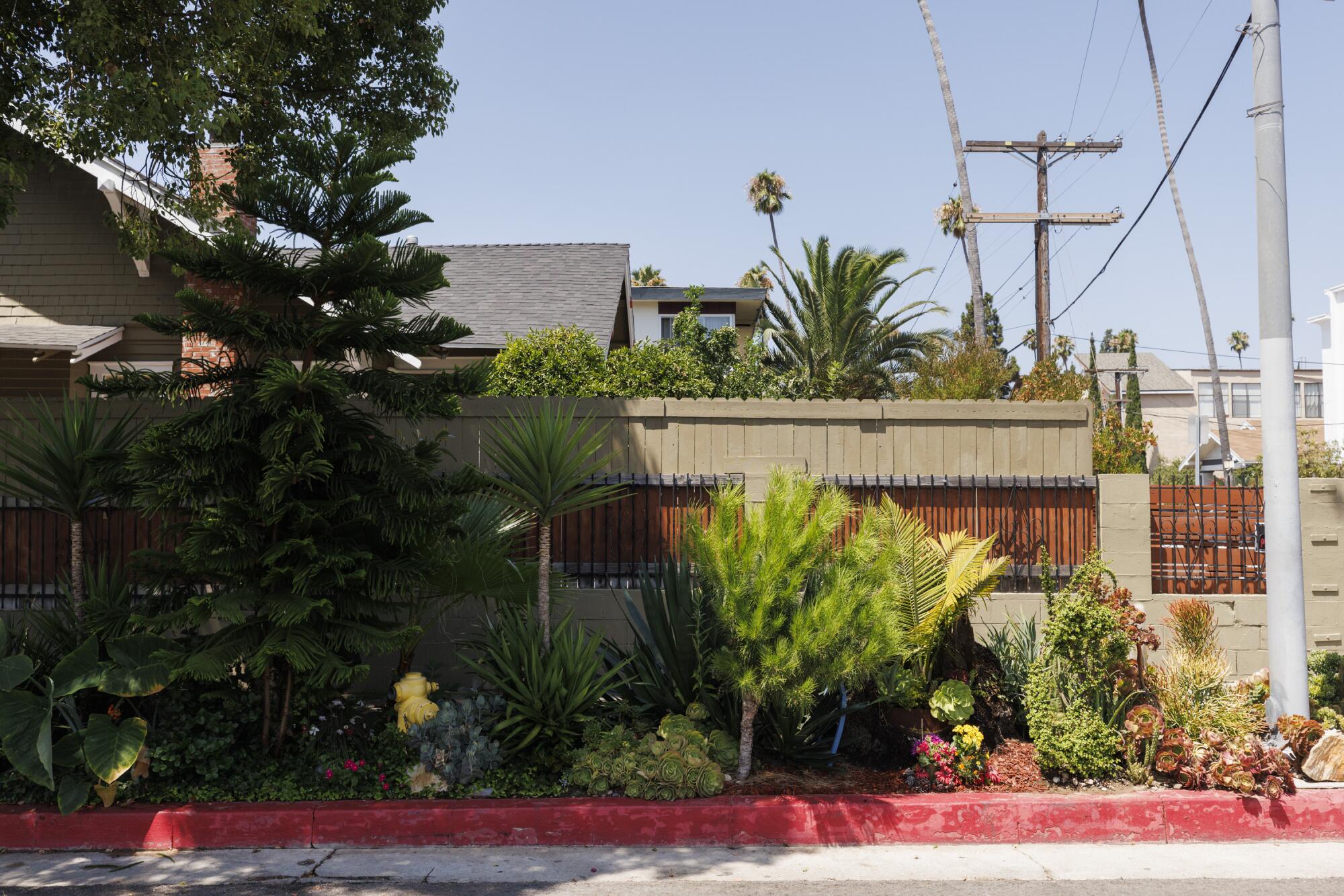
“It feels like a mini-forest if you’re on Sunset and then come this way,” said Jim Stewart of the garden he helped create.
(Carlin Stiehl / For The Times)
A towering Cook pine tree stretches its bright green needles above the wide elephant-ear leaves of a taro plant and a jagged yucca. A designated desert section features cacti — one adorned with a big white flower — succulents, sand and rocks. Vines creep up a parking sign. Quirky flourishes give it the air of an installation: gold thumbtacks arranged in designs on dead stumps, fake flowers peeking out amid real ones, an attempt at a topiary and a patched sidewalk crack studded with plastic rhinestones.
Animals and people are drawn to the patch of green space, creating a makeshift community hub in a city known for disconnection. Black widows hunt nuisance bugs, while monarch butterflies flit between tufts of bright orange milkweed that started growing on its own. Coyotes, opossums and skunks prowl. Neighbors regularly chat with Cura and Stewart as they garden, and some have become good friends — including the woman who owns the house abutting the parkway, who they didn’t know when they embarked on the multiyear project.
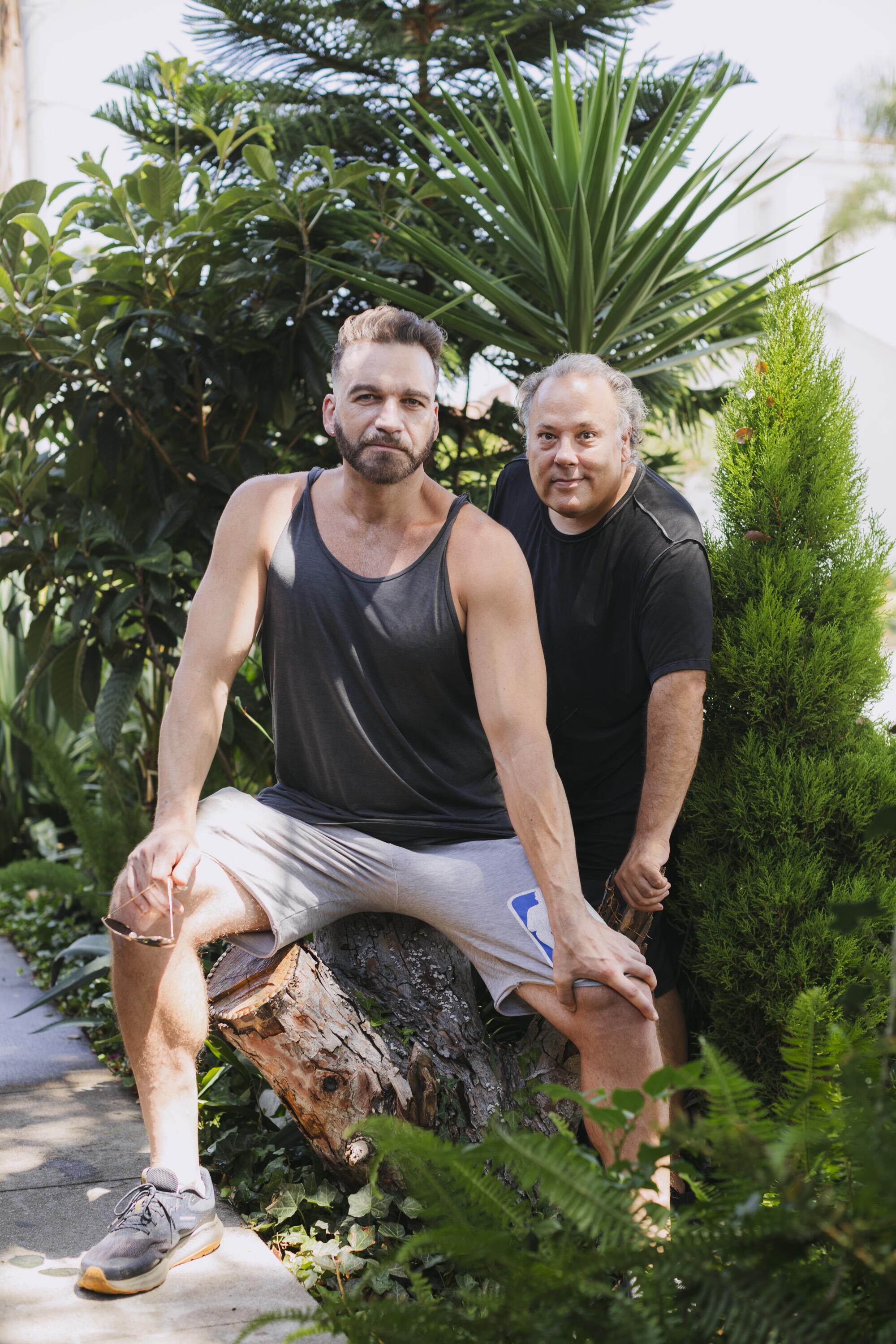
Francesco Cura, left, and Jim Stewart said they now “know everyone” in the neighborhood after investing four years into rehabbing a trash-covered strip of land.
(Carlin Stiehl / For The Times)
Once anonymous in the neighborhood, “we know everyone,” said Stewart, who lives about a 5-minute drive from the parkway. “I will go to Ralph’s and the girl checking me out will be, like ‘I love the garden!’”
A “before” photo of the space depicts an area near a camphor tree invaded with wadded up napkins, plastic bags, a disposable cup, a store receipt and part of an inscrutable object consisting of a long metal pole on a base. The soil isn’t visible.
Homeowners in Los Angeles can landscape so-called residential parkways adjacent to their properties without permits if they comply with the city’s guidelines and follow certain requirements, such as making sure plants don’t exceed a certain height and are drought tolerant or resistant. In fact, they’re required to maintain the patches in the public right-of-way even if they don’t change the landscaping. Permits are required, however, to plant trees.
Bambi Anderson, 66, lives in the same building as Cura, down the block from the garden, but met him on the sidewalk about six years ago while he was working on a different project.
Anderson, a former dancer, often admired a defunct payphone near her apartment decorated with black-and-white comics, lights and other dressings. One day she saw Cura working on it and struck up a conversation.
It reminded her of the “old days,” when she was growing up in New York in the 1970s and people living under one apartment roof knew and talked to each other.
Although her daughter lives just over the hill and friends are nearby, she lives alone in a studio apartment. “It’s nice to know that I can call [neighbors] and be like, ‘Hey.’ You know, whatever,” Anderson said. “We’re all passing ships, but we often take time to just talk about what’s happening in our lives.”
Minutes ago, she met another neighbor, Justin Black, who Cura and Stewart had called over. “So if I see him now, I’ll know, and I’ll make that connection.”
Black, a 37-year-old merchandiser, is a new face in the orbit. When he returned to the neighborhood two months ago after a stint in the Valley, he was astounded by the progress of the garden, which he had seen rise in its early days. When he saw the duo working on it, he said he approached them: “I’m like, ‘What is this? Tell me everything.’”
1
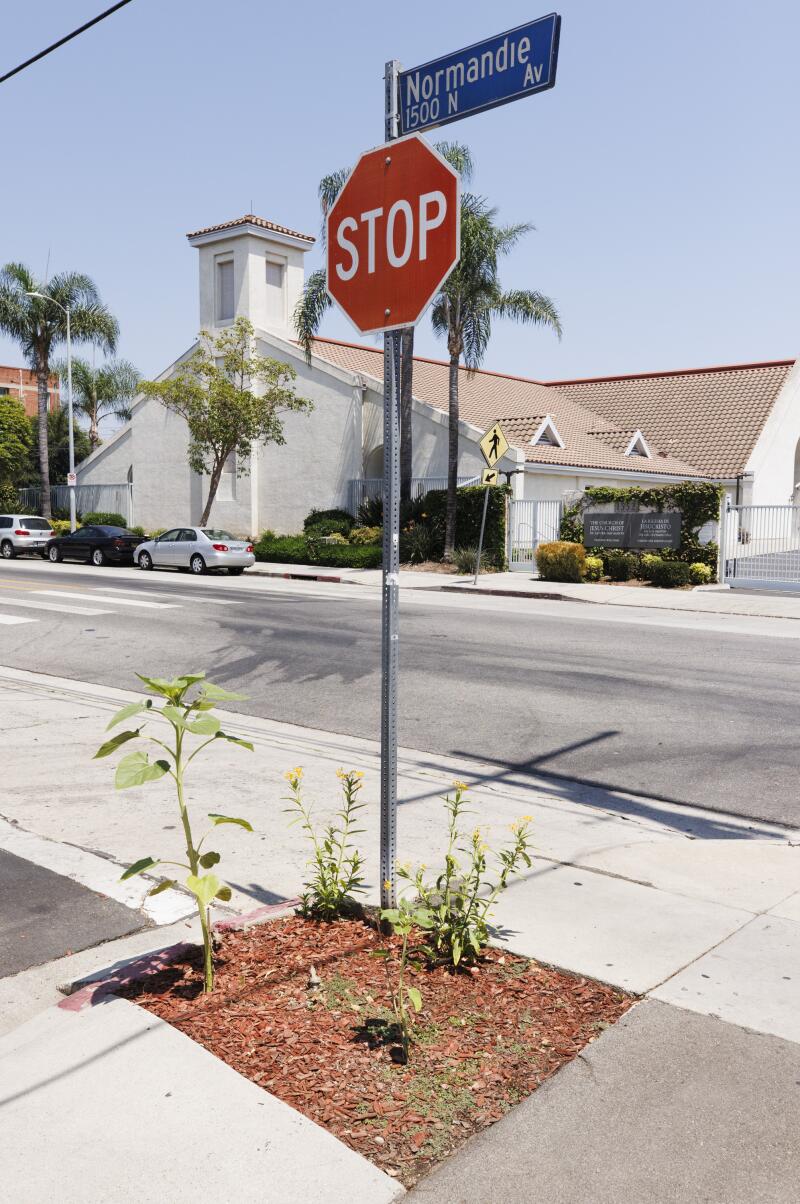
2

3
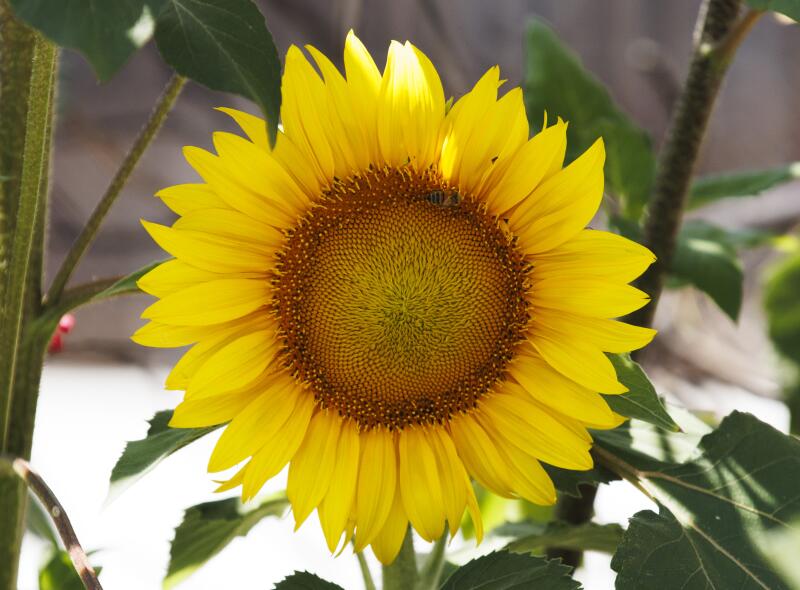
1. Plants, including milkweed, grow around a stop sign. 2. A succulent flourishes at the garden. 3. A sunflower in perfect bloom in an area recently rehabbed by Cura and Stewart. (Carlin Stiehl / For The Times)
Cura and Stewart met 20 years ago. Stewart was taking Cura’s headshot, and they instantly connected. (Cura, once a model and actor, has graced the cover of numerous romance novels.) Cura hails from Parma, Italy, and Stewart from Midwest City, Okla.; both lived in New York. Neither had gardening experience and had no intention of greening their thumbs when they first cleared the parkway. Filling the space with plants seemed like a way to deter trash and homeless encampments from returning, they recall.
Proficiency has emerged through research, trial-and-error and hours of toil. During the height of the pandemic, when work was scarce, they’d spend around six hours a day on the garden. “It was insane,” Cura said, “But I got into it so much that I couldn’t stop.”
When they began, the dirt was hard and gray. Now it’s black and powdery. At one point Cura and Stewart decided they wanted worms. So they picked up red wigglers from a kid-owned business in Studio City and set them loose. On a recent visit to the garden, they excitedly talked over each other as they explained the benefits of the worms — the way they create holes in the soil and fertilize it with their poop. “I’m just a dirt person,” Stewart said.
Periodically, they lighted up cigarettes as they explained the sometimes wacky provenance of various plants.
An elderly neighbor who owned a nearby apartment complex donated the Cook pine, which they said was near death due to neglect. Though they have no concrete proof, they firmly believe a man stole a rubber tree and then planted another tree — identified as a tropical fruiting variety called mertajam by an app — to make amends. An avocado pit thrown into the garden is now sprouting in a glass jar on a neighbor’s stoop. Cura and Stewart hold a particular affection for an Italian stone pine, a symbol of Rome, that was rescued from the trash.
The role of accidental steward of the community greenspace comes with its share of challenges and responsibilities.
Plant theft and destruction is rampant. Trash still appears. The land requires tending, and they wish the area was better lighted. The duo estimates they’ve spent about $1,500, including purchasing tools and worms. They’ve invested untold hours of labor into maintaining a space they don’t and can’t own.
Yet they delight in the joy it brings people, the daily “thank yous” from strangers and friends. They’ve noticed heightened respect for the area evinced by a decrease in dumping. And it seems that, almost in spite of themselves, they continue to find new projects. About two months ago, they refreshed half a parkway across the street. Dry grass was replaced with red and yellow sunflowers and cacti. A white butterfly recently flitted among the blooms, and a woman stopped to snap photos.
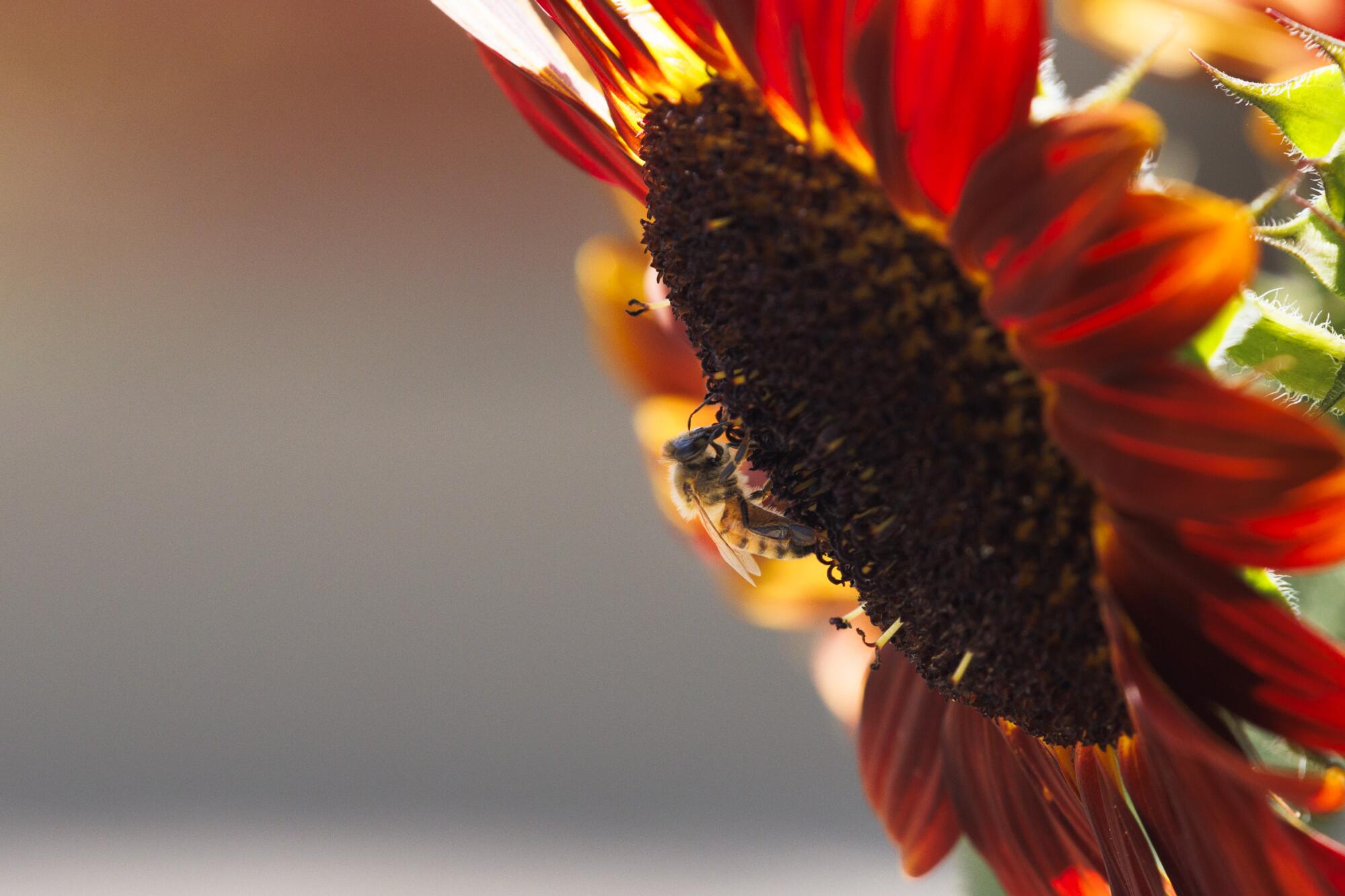
Bees and butterflies gravitate to plants that rise in the parkway, including this sunflower grown from seed. Francesco Cura is adamant that carpenter bees that frequent the area recognize him — and love being hosed down with water.
(Carlin Stiehl / For The Times)
The project has put the guerrilla gardeners in a bittersweet bind.
“I’m not planning on leaving, but if I have a random thought about possibly going somewhere else, this comes up in my mind,” Cura said earlier this summer. “I know that I shouldn’t be that attached because, you know, it’s not my garden, and it shouldn’t keep you from doing other things. But certainly there was an attachment to it because we’ve seen these plants grow, and most of them were from little cuts, tiny little things, that developed into huge plants.”
The palm tree stump that spurred Cura to action remains. Instead of trash, it’s filled with an assortment of plants.

Jim Stewart, left, and Francesco Cura admit that maintaining the garden is not always a bed of roses. But they’re energized by the joy it brings people. “Every day … someone will say thank you,” Stewart said.
(Carlin Stiehl / For The Times)

